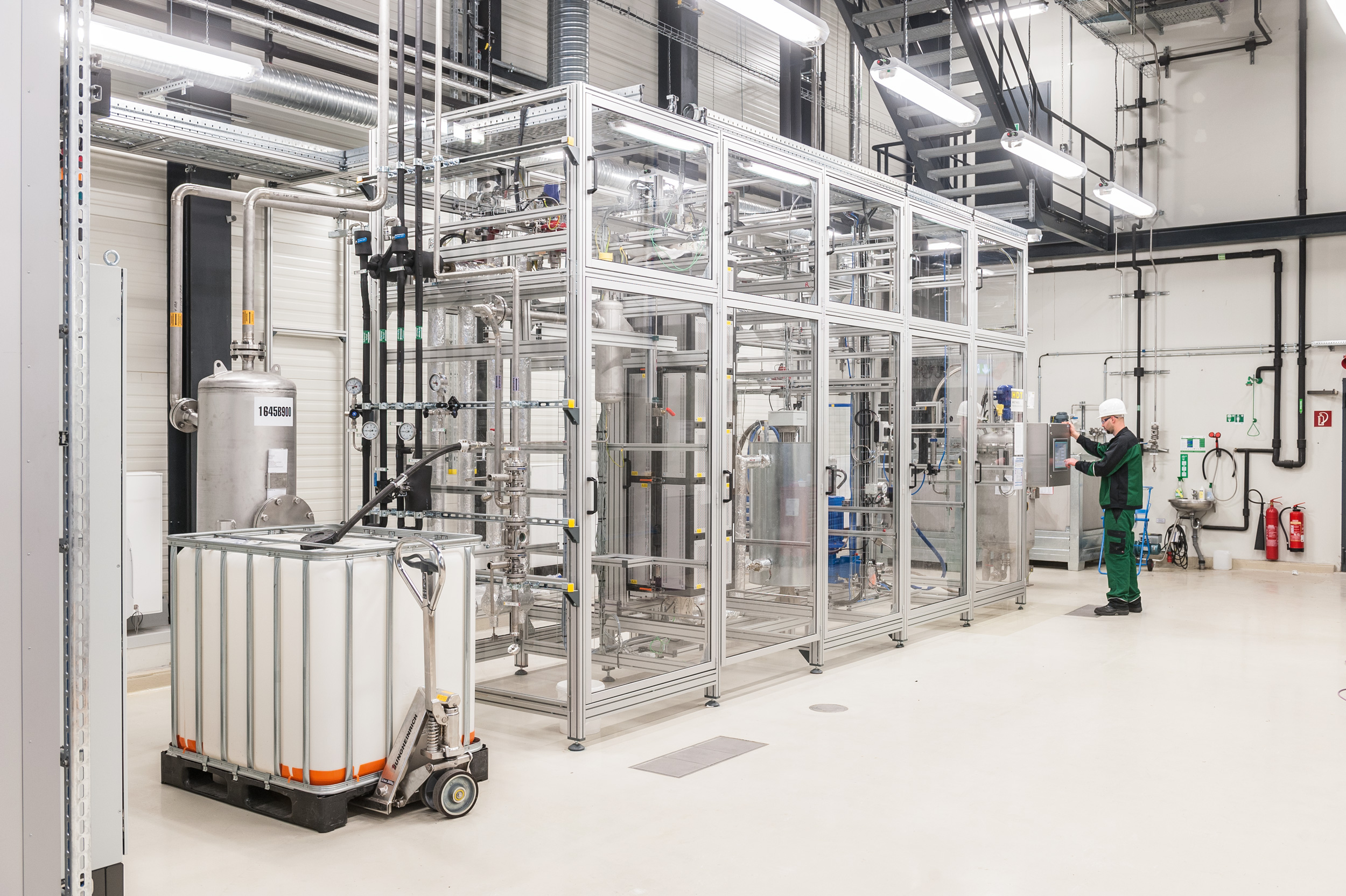Jahr
Year | Titel/Autor:in
Title/Author | Publikationstyp
Publication Type |
|---|
| 2022 |
Products and applications of different lignins from biorefineries
Unkelbach, Gerd; Hirth, Thomas |
Zeitschriftenaufsatz
Journal Article
|
| 2022 |
Prospects and opportunities for Eastern Germany for a competitive hydrogen economy
Brock, Laura Victoria; Ventz, Hannah; Growitsch, Christian; Pufky-Heinrich, Daniela |
Zeitschriftenaufsatz
Journal Article
|
| 2022 |
Green hydrogen as a key enabler for the bioeconomy
Pufky-Heinrich, Daniela |
Zeitschriftenaufsatz
Journal Article
|
| 2021 |
Platform and fine chemicals from woody biomass: Demonstration and assessment of a novel biorefinery
Nitzsche, R.; Gröngröft, A.; Köchermann, J.; Meisel, K.; Etzold, H.; Verges, Marlen; Bachmann, J.; Leschinsky, Moritz; Saake, B.; Torkler, Sandra; Rößiger, B.; Patzsch, Katja; Pufky-Heinrich, D.; Unkelbach, Gerd |
Zeitschriftenaufsatz
Journal Article
|
| 2021 |
v-Carotene extraction from Dunaliella salina by supercritical CO2
Ludwig, K.; Rihko-Struckmann, L.; Brinitzer, Gordon; Unkelbach, G.; Sundmacher, K. |
Zeitschriftenaufsatz
Journal Article
|
| 2021 |
Kinetic modeling of the continuous hydrothermal base catalyzed depolymerization of pine wood based kraft lignin in pilot scale
Bernhardt, Justin; Rößiger, Björn; Hahn, Thomas; Pufky-Heinrich, Daniela |
Zeitschriftenaufsatz
Journal Article
|
| 2020 |
Valorization of Lignin via Oxidative Depolymerization with Hydrogen Peroxide: Towards Carboxyl-Rich Oligomeric Lignin Fragments
Junghans, U.; Bernhardt, J.J.; Wollnik, R.; Triebert, D.; Unkelbach, G.; Pufky-Heinrich, D. |
Zeitschriftenaufsatz
Journal Article
|
| 2020 |
The resource principle. Utilization and intelligent reprocessing routes for wood-based materials, natural fibers and organic residues
Kasal, Bohumil; Leschinsky, Moritz; Oehr, Christian; Unkelbach, Gerd; Wolperdinger, Markus |
Aufsatz in Buch
Book Article
|
| 2019 |
Das Wertstoff-Prinzip
Kasal, Bohumil; Leschinsky, Moritz; Oehr, Christian; Unkelbach, Gerd; Wolperdinger, Markus |
Aufsatz in Buch
Book Article
|
| 2019 |
Bioraffineriekonzepte: Mehr erreichen, ohne zu pressen
Pufky-Heinrich, Daniela; Steffler, Fabian; Börner, Gunter |
Zeitschriftenaufsatz
Journal Article
|
| 2019 |
Bio-Based Epoxy Resins Based on Linseed Oil Cured with Naturally Occurring Acids
Thiele, K.; Eversmann, N.; Krombholz, A.; Pufky-Heinrich, D. |
Zeitschriftenaufsatz
Journal Article
|
| 2018 |
Feasibilty study on the etherification of fermentative-produced isobutylene to fully renewable ethyl tert-buytl ether (ETBE)
Tretbar, Maik; Witzel, Thomsen; Hauffe, Anika; Junghans, Ulrike; Bulc, Ales; Pufky-Heinrich, Daniela |
Zeitschriftenaufsatz
Journal Article
|
| 2018 |
Neue Produkte aus Ölsaaten - Der Weg zu innovativen Bioraffineriekonzepten
Steffler, Fabian; Börner, Gunter; Pufky-Heinrich, Daniela |
Zeitschriftenaufsatz
Journal Article
|
| 2018 |
From wood to resin - identifying sustainability levers through hotspotting lignin valorisation pathways
Lettner, Miriam; Solt, Pia; Rößiger, Björn; Pufky-Heinrich, Daniela; Jääskeläinen, Anna-Stiina; Schwarzbauer, Peter; Hesser, Franziska |
Zeitschriftenaufsatz
Journal Article
|
| 2018 |
Ethanolische native Extraktion geschälter Rapssaat
Steffler, Fabian; Franke, Sandra; Röver, Robert; Piór, A.; Börner, Gunter; Pufky-Heinrich, Daniela |
Zeitschriftenaufsatz
Journal Article
|
| 2018 |
Base-catalyzed depolymerization of lignin: History, challenges and perspectives
Rößiger, Björn; Unkelbach, Gerd; Pufky-Heinrich, Daniela |
Aufsatz in Buch
Book Article
|
| 2017 |
Production of Bio-Phenols for Industrial Application
Rößiger, B.; Röver, R.; Unkelbach, G.; Pufky-Heinrich, D. |
Zeitschriftenaufsatz
Journal Article
|
| 2017 |
Süße Additive. Biobasierte Benzinzusatzstoffe
Pufky-Heinrich, Daniela; Bulc, Ale |
Internetbeitrag
Internet Contribution
|
| 2017 |
Von fossilen zu biogenen Rohstoffen
Hirth, Thomas; Unkelbach, Gerd |
Aufsatz in Buch
Book Article
|
| 2016 |
Process scale-up for the production of bioaromatic compounds from lignin
Pufky-Heinrich, Daniela; Rößiger, Björn; Röver, Robert; Unkelbach, Gerd |
Zeitschriftenaufsatz
Journal Article
|
| 2016 |
Vom Holz zum Biopolymer - Theorie und Praxis
Unkelbach, Gerd; Fritsch, M. |
Zeitschriftenaufsatz
Journal Article
|
| 2016 |
Verfahren zur Fällung von Lignin aus Organosolv-Kochlaugen
Leschinsky, Moritz; Unkelbach, Gerd; Schulze, Peter; Lorenz, Heike; Seidel-Morgenstern, Andreas |
Patent
|
| 2016 |
Advanced process for precipitation of lignin from ethanol organosolv spent liquors
Schulze, Peter; Seidel-Morgenstern, Andreas; Lorenz, Heike; Leschinsky, Moritz; Unkelbach, Gerd |
Zeitschriftenaufsatz
Journal Article
|
| 2014 |
Assessment of an Organosolv lignocellulose biorefinery concept based on a material flow analysis of a pilot plant
Laure, S.; Leschinsky, Moritz; Fröhling, M.; Schultmann, F.; Unkelbach, G. |
Zeitschriftenaufsatz
Journal Article
|
| 2014 |
Aromatische Molekülbausteine aus Lignin
Pufky-Heinrich, D.; Unkelbach, G. |
Zeitschriftenaufsatz
Journal Article
|
| 2014 |
Vom Schüttelkolben in die Industrie
Unkelbach, Gerd |
Zeitschriftenaufsatz
Journal Article
|
| 2012 |
Neue Strategien - Holz als Rohstoff für die chemische Industrie
Pufky-Heinrich, D.; Leschinsky, Moritz; Unkelbach, G. |
Zeitschriftenaufsatz
Journal Article
|
| 2012 |
Verfahren zur Herstellung von Ethylen und anderen Olefinen aus wässrigen Lösungen der korrespondierenden Alkohole
Unkelbach, Gerd; Schweppe, Rainer; Hirth, T. |
Patent
|
| 2012 |
Stoffliche Nutzung von Lignin. Ein Beitrag zur ganzheitlichen stofflichen Nutzung von Biomasse. Tl. 2: Chemische und biochemische Spaltung von Lignin in Aromaten
Hirth, Thomas; Unkelbach, G.; Zibek, S.; Staiger, Nadine; Leschinsky, Moritz |
Zeitschriftenaufsatz
Journal Article
|
| 2012 |
Stoffliche Nutzung von Lignin. Ein Beitrag zur ganzheitlichen stofflichen Nutzung von Biomasse. TI.1: Hintergrund, Rohstoffe, Gewinnung und Nutzung unter Erhalt der polymeren Struktur
Hirth, Thomas; Unkelbach, G.; Leschinsky, Moritz |
Zeitschriftenaufsatz
Journal Article
|
| 2011 |
Biobasierte Monomere und Polymere
Hirth, Thomas; Fehrenbacher, Ulrich; Kowollik, Kristian; Krischke, Wolfgang; Krügener, Sven; Rupp, Steffen; Schweppe, Rainer; Unkelbach, Gerd; Zibek, Susanne |
Aufsatz in Buch
Book Article
|
| 2010 |
Nanopartikel-Enzym-Konjugate für die Entwicklung von Biosensoren
Pufky-Heinrich, D.; Weber, A. |
Zeitschriftenaufsatz
Journal Article
|
| 2010 |
Evaluation of gelatin-based cell substrates and 3D microstructuring by multiphoton polymerization
Hoch, Eva; Engelhardt, S.; Pufky-Heinrich, D.; Kluger, Petra; Hirth, Thomas; Tovar, G.; Borchers, K. |
Poster
|
| 2010 |
Photocrosslinking and 3D microstructuring of gelatin for the generation of substrates for artificial cartilage
Hoch, Eva; Engelhardt, S.; Pufky-Heinrich, D.; Kluger, Petra; Hirth, Thomas; Tovar, G.; Borchers, K. |
Poster
|
| 2009 |
Biomimetic nanoparticles providing molecularly defined binding sites - protein-featuring structures versus molecularly imprinted polymers
Borchers, K.; Genov, S.; Gruber-Traub, C.; Niedergall, K.; Plankalayil, J.; Pufky-Heinrich, D.; Riegler, J.; Schreiber, T.; Tovar, G.E.M.; Weber, A.; Wojciukiewicz, D. |
Aufsatz in Buch
Book Article
|
 Fraunhofer Institute for Interfacial Engineering and Biotechnology IGB
Fraunhofer Institute for Interfacial Engineering and Biotechnology IGB